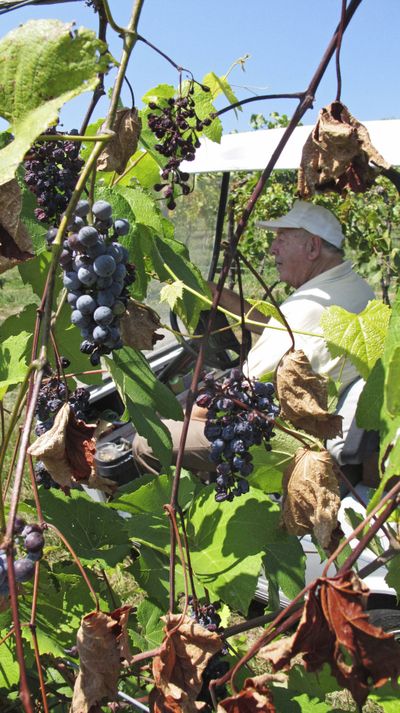Wines flourish in heartland
Vintners think drought will increase fruitiness

HERMANN, Mo. – Most of the grapes in Glenn Warnebold’s vineyard in Missouri’s picturesque wine country are about two-thirds their usual size. Others have been reduced to raisins by the drought that burned up many crops across the Midwest this summer.
Yet Warnebold figures it could be a good year with the drought concentrating the fruit’s flavors and sugar, which will turn to alcohol during fermentation. His red Norton and white Chardonel grapes, while small, hold the promise of standout wine from a region better known for corn and soybeans.
Wineries have been popping up in grape-growing regions of Missouri, Michigan and other Midwestern states for years, but they’ve generally been seen more as tourist draws than quality vintners. Some are hoping this year will help change that, and in a summer that has been devastating for most farmers, grape growers have a bit to cheer.
“The fruit will be better, overall, for reds and whites, than last year, when it was wet,” said Tony Debevc, who has a 170-acre Ohio vineyard. “If it continues to be dry like this, the wine industry will be better overall. And personally, we can expand in the red category, and it wouldn’t necessarily be a bad thing.”
That’s not to say everything is rosy. The drought still stressed the vines, making them less likely to survive a harsh winter and produce next season. But vineyard owners say the varieties commonly planted in the Midwest have roots that can reach dozens of feet below the surface to get at water tables.
The harvest will almost certainly be smaller too. Warnebold figures he will get 2,500 cases of wine this year – 1,500 less than what he typically might expect – from his six-acre vineyard atop a bluff overlooking the Missouri River. But he routinely has set cases from each year aside as a hedge against “bad years,” so there won’t be a shortage.
This year’s wines from the heartland “will be nice, fruity and very approachable and soft on the palate,” predicted Diego Meraviglia, vice president for the California-based North American Sommelier Association.
But he believes the drought has cost some grape varieties complexities that may hinder the wines’ abilities to age, meaning “you have to drink them within a year or they’ll go bad.”
“It’ll be enjoyable right off the bat,” he said. “But real connoisseurs who drink aged wine will be disappointed.”
Warnebold bristled at the suggestion. “I’ve been to a lot of wine conferences with a lot of wine experts, and I’ve never heard that theory before,” he said.
Brad Beam, an Illinois Grape Growers and Vintners Association enologist, downplayed the debate, saying “a lot of our wine is best drunk on the young side anyway.”